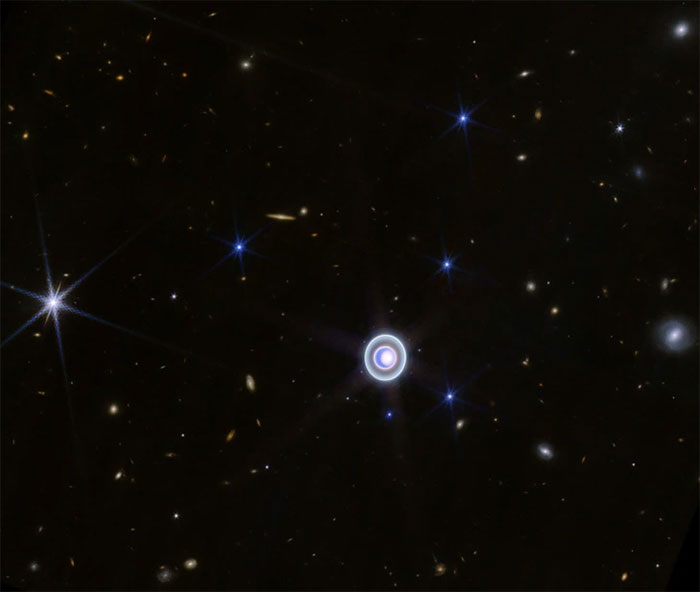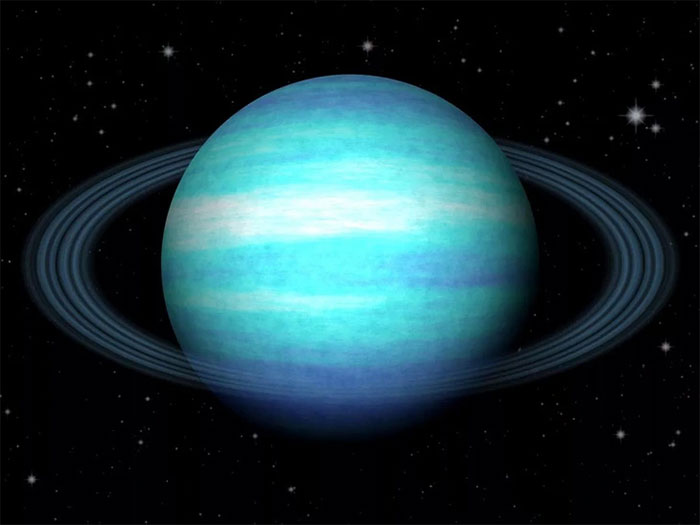NASA releases never-before-seen images of Uranus
New images reveal many mysteries of Uranus, one of the most distant planets in the Solar System.
The US National Aeronautics and Space Administration (NASA) has just released the latest, clearest images ever of Uranus, one of the most distant planets in the Solar System.

The latest image revealed by NASA about Uranus - (Photo: NASA).
The image was captured by the James Webb Space Telescope, focusing on the inner and outer rings of Uranus. The superior power of James Webb allows it to clearly capture even the faintest rings that current telescopes cannot fully capture.
The white specks on the planet's rings are made of dust, rocks, and ice. Meanwhile, Uranus's atmosphere also has white specks, which are layers of ice. The closer you get to the poles, the more obvious the ice layers are.
Polar ice caps are also characteristic of Uranus as its great distance from the Sun makes the planet extremely cold.

The characteristic rings of Uranus - (Photo: NASA).
The information that has been discovered shows that one orbit of Uranus around the Sun is equivalent to 84 Earth years. That is, the polar regions here will have 42 years of complete darkness followed by 42 years of continuous light.
That is one of the reasons why Uranus's polar regions have always been among the coldest in the Solar System.
Astronomers say new images from NASA show a storm forming beneath the southern part of the Antarctic ice cap . The storm may be caused by annual cyclical meteorological effects.
Storms in the atmosphere of Uranus have long been a fascinating subject of study for scientists. They discovered that because Uranus' orbit is tilted so much, up to 98 degrees, the difference between seasons is very severe, creating conditions for extreme weather phenomena.

Uranus's satellites are seen circling the planet - (Photo: NASA).
Using infrared imaging, James Webb also captured rare images of Uranus's moons. The planet has a total of 27 known moons.
Currently, telescopes larger than 25cm can see some of Uranus's large satellites such as Titania or Oberon.
NASA believes that new discoveries through the latest photos taken by James Webb will pave the way for future missions to explore this distant planet in the Solar System.
- 'Unbelievable' facts about the Uranus star
- The first image of Uranus
- Shock: blue planet in Solar System is 'transforming'
- Could a planet so close to Earth be full of swimming fish?
- Scientists have discovered that Uranus is not completely filled with ice
- Discovered 'copy' of Uranus
- Aurora on Uranus
- Uranus - The most exotic planet in the Solar System
- Discover the green belt around the Uranus
- Special points of Uranus
- Astronomers claim that Uranus smells like ... fart
- NASA opens the door to document 140,000 stunning images of the universe for the whole world
 Van Allen's belt and evidence that the Apollo 11 mission to the Moon was myth
Van Allen's belt and evidence that the Apollo 11 mission to the Moon was myth The levels of civilization in the universe (Kardashev scale)
The levels of civilization in the universe (Kardashev scale) Today Mars, the sun and the Earth are aligned
Today Mars, the sun and the Earth are aligned The Amazon owner announced a secret plan to build a space base for thousands of people
The Amazon owner announced a secret plan to build a space base for thousands of people